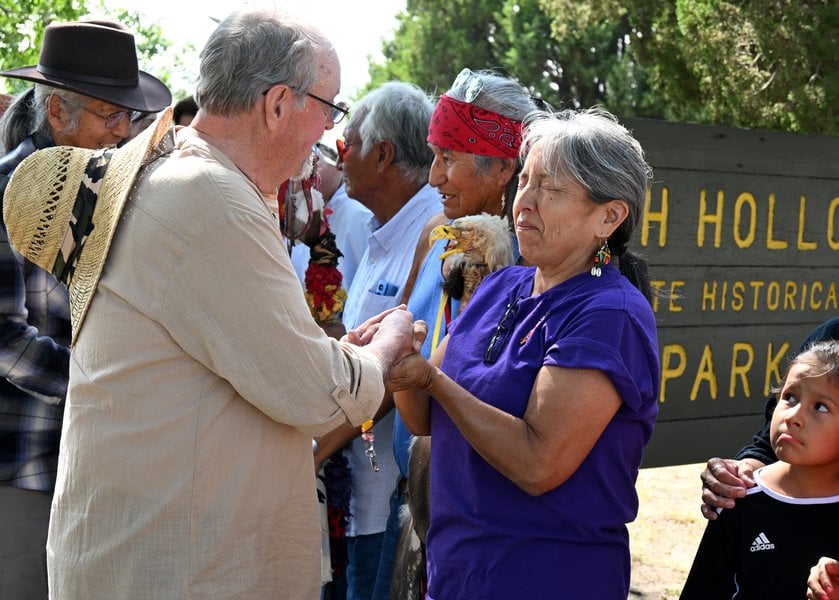Karen Little Thunder and her cousin Phil Little Thunder greet attendees of a memorial ceremony in Ash Hollow State Historical Park Sept. 6, 2025. Photo courtesy Jessica Wade, Nebraska Public Media
170 Years Ago, The US Army Massacred A Lakota Village. Their Plundered Belongings Are Now Back In Nebraska
by Jessica Wade, Nebraska Public Media
Karen Little Thunder stood outside a small storage room within the Ash Hollow State Historical Park welcome center. She lit a small bundle of sage and wafted the cleansing smoke over anyone who wished to pass through the doorway. The spirits of her ancestors were in that room, attached to the historic belongings carefully set atop a table. Two pairs of moccasins, an intricately beaded bag, a bow and a small doll were among the items, all of which were plundered more than a century ago from a Lakota community massacred just a few miles north of where the welcome center now stands.
Locally Extinct For A Century, Bay Scallops Thriving Again On Virginia Shore Of Chesapeake Bay
by Good News Network
Bay scallops are making an incredible resurgence in coastal bays along Virginia’s Eastern Shore, according to a new survey. The exponential population growth is the result of decades of dedicated seagrass restoration efforts that allowed scientists to reintroduce the species to its former home. Locally extinct since the 1930s due to habitat loss, bay scallops are thriving again, with help from the College of William & Mary’s and VIMS Eastern Shore Laboratory (ESL) in Wachapreague, Virginia. The comeback could possibly set the stage for a future recreational fishery.
A ‘Secret Weapon’ For Fighting Climate Change Comes Surging Back
by Jennifer Cole, Reasons to Be Cheerful
In late spring last year, Betty Hodgson, president of the Nova Scotia non-profit group Friends of the Pugwash Estuary, sat in the bow of a small boat with Kristina Boerder, a marine biologist at Dalhousie University. As they maneuvered the dingy through the shallow estuarine waters that flow undaunted into Canada’s Northumberland Strait, the pair leaned over the boat’s edge, scanning below the rippling surface for any sign of silvery-green ribboned blades of eelgrass. What they were really looking for was hope. Eelgrass, or Zostera marina, is part of the seagrass family of plants and the most common seagrass species in Canada.
This Little-Known Appeal Could Force Your Insurer To Pay For Lifesaving Care. Here’s How To File It.
by Duaa Eldeib, ProPublica
When a health insurance company refuses to pay for treatment, most people begrudgingly accept the decision. Few patients appeal; some don’t trust the insurer to reverse its own decision. But a little-known process that requires insurers and plans to seek an independent opinion outside their walls can force insurers to pay for what can be lifesaving treatment. External reviews are one of the industry’s best-kept secrets, and only a tiny fraction of those eligible actually use them. Here are six steps experts suggest to help you through the external appeal process.
A Nation That’s 90% Rainforest Announces New Protections For Over 25 Million Acres
by Andy Corbley, Good News Network
Huge news broke recently when a country with more intact forests than any other on Earth decided that 90% of all forest cover would be preserved by law. Made in New York in advance of a UN summit that will see the party members to the Framework Conference on Climate Change (UNFCCC) meet for the 30th time, the decision was heralded as a major step in the effort to protect 30% of all natural landscapes on Earth. The nation in question was Suriname, the former Dutch colony located on the northern coast of South America, bordering Brazil to the south, and Guyana to the west.


Recent Comments